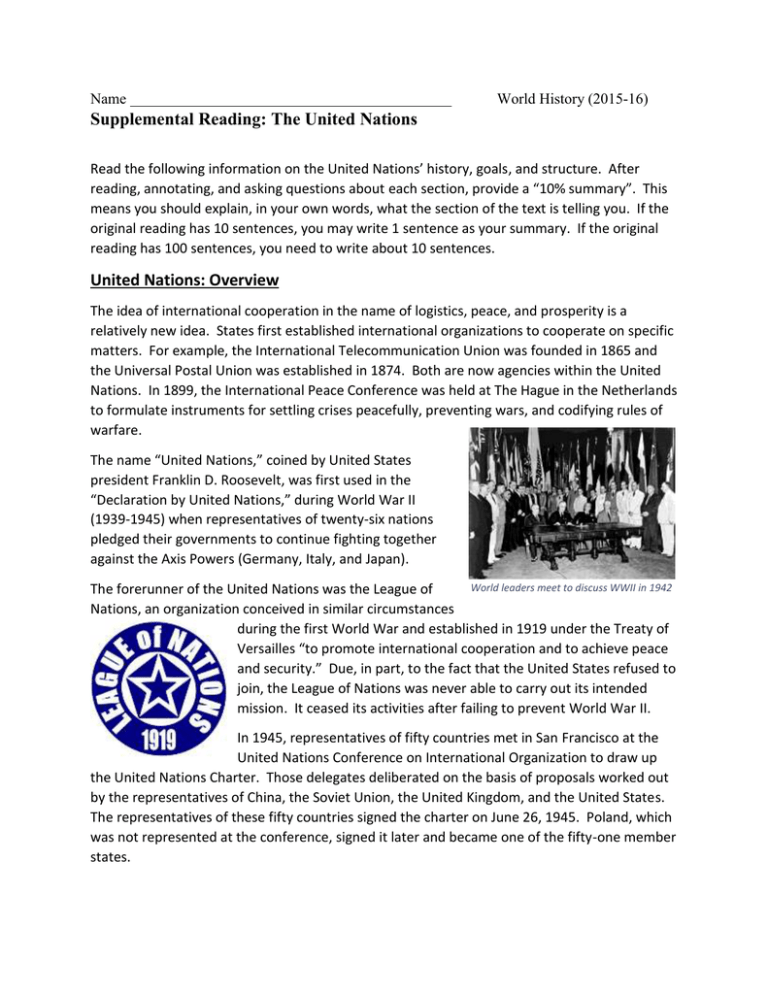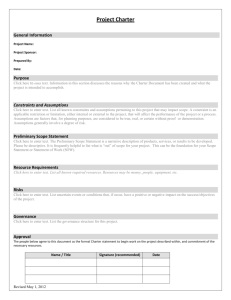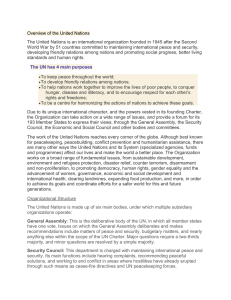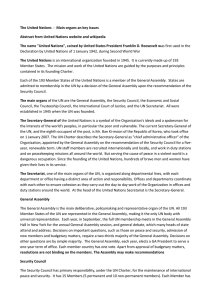United Nations Reading 10% Summary Activity
advertisement

Name World History (2015-16) Supplemental Reading: The United Nations Read the following information on the United Nations’ history, goals, and structure. After reading, annotating, and asking questions about each section, provide a “10% summary”. This means you should explain, in your own words, what the section of the text is telling you. If the original reading has 10 sentences, you may write 1 sentence as your summary. If the original reading has 100 sentences, you need to write about 10 sentences. United Nations: Overview The idea of international cooperation in the name of logistics, peace, and prosperity is a relatively new idea. States first established international organizations to cooperate on specific matters. For example, the International Telecommunication Union was founded in 1865 and the Universal Postal Union was established in 1874. Both are now agencies within the United Nations. In 1899, the International Peace Conference was held at The Hague in the Netherlands to formulate instruments for settling crises peacefully, preventing wars, and codifying rules of warfare. The name “United Nations,” coined by United States president Franklin D. Roosevelt, was first used in the “Declaration by United Nations,” during World War II (1939-1945) when representatives of twenty-six nations pledged their governments to continue fighting together against the Axis Powers (Germany, Italy, and Japan). World leaders meet to discuss WWII in 1942 The forerunner of the United Nations was the League of Nations, an organization conceived in similar circumstances during the first World War and established in 1919 under the Treaty of Versailles “to promote international cooperation and to achieve peace and security.” Due, in part, to the fact that the United States refused to join, the League of Nations was never able to carry out its intended mission. It ceased its activities after failing to prevent World War II. In 1945, representatives of fifty countries met in San Francisco at the United Nations Conference on International Organization to draw up the United Nations Charter. Those delegates deliberated on the basis of proposals worked out by the representatives of China, the Soviet Union, the United Kingdom, and the United States. The representatives of these fifty countries signed the charter on June 26, 1945. Poland, which was not represented at the conference, signed it later and became one of the fifty-one member states. The United Nations officially came into existence on October 24, 1945, when the charter had been ratified by China, France, the Soviet Union, the United Kingdom, the United States, and by a majority of other signatories. 10% Summary: The UN: Security Council The primary decision-making organization representing all 193 member nations is called the General Assembly. The real power, though, rests with the Security Council. The Security Council discusses and votes on major security issues facing the UN. It is charged with keeping world peace and may vote to take action against a member nation or non-member nation in order to keep the peace and protect lives at risk. According to the Charter, the United Nations, as led by the Security Council, has four purposes: to maintain international peace and security; to develop friendly relations among nations; to cooperate in solving international problems and in promoting respect for human rights; and to be a center for harmonizing the actions of nation. The United Nations' logo There are five permanent members of the Security Council: the United States, Russia, the United Kingdom, France, and China. All five permanent members of the Security Council must agree before any action is approved. The other members of the Security Council are elected by the General Assembly and serve two year terms. The countries that currently sit on the Security Council are: Angola, Chad, Chile, Jordan, Lithuania, Malaysia, New Zealand, Nigeria, Spain, and Venezuela. 10% Summary: How the Security Council Works When a complaint concerning a threat to peace is brought before it, the Council’s first action is usually to recommend that the parties try to reach agreement by peaceful means. The Council may: set forth principles for such an agreement; undertake investigation and meditation, in some cases; appoint special envoys; or request the Secretary-General to use his good offices to achieve a peaceful settlement of the dispute. When a dispute leads to hostilities, the Council’s primary concern is to bring them to an end as soon as possible. In that case, the Council may: issue ceasefire directives that can help prevent an escalation of the conflict; dispatch military observers or a peacekeeper force to help reduce tensions, separate opposing forces and establish a calm in which peaceful settlements may be sought. Beyond this, the Council may opt for enforcement measures, including: economic sanctions, arms embargoes, financial penalties and restrictions, and travel bans; blockade; or even collective military action. A chief concern is to focus action on those responsible for the policies or practices condemned by the international community, while minimizing the impact of the measures taken on other parts of the population and economy. All members of the United Nations agree to accept and carry out the decisions of the Security Council. While other organs of the UN make recommendations to member states, only the Security Council has the power to make decisions that member states are obligated to implement under the Charter. The Security Council held its first session on January 17, 1946 in London. Since its first meeting, the Security Council has taken permanent residents at the United Nations Headquarters in New York City. A representative of each of its members must be present at all times at UN Headquarters so that the Security Council can meet at any time as the need arises. UN Headquarters, New York City 10% Summary: The UN: Beyond the Security Council There are several main arteries such as the Economic and Social Council which established regional committees for Africa, Asia, Europe, Latin America and the Caribbean, Asia and the Pacific, and western Asia. There is a Trusteeship Council, Office of the Secretary General (known as the Secretariat), and the International Court of Justice. The International Court of Justice (ICJ) is the principal judicial organ of the United Nations (UN). It was established in June 1945 by the Charter of the United Nations and began work in April Inside the ICJ 1946. The seat of the Court is at the Peace Palace in The Hague (Netherlands). Of the six principal organs of the United Nations, it is the only one not located in New York (United States of America). The Court’s role is to settle, in accordance with international law, legal disputes submitted to it by States and to give advisory opinions on legal questions referred to it by authorized United Nations organs and specialized agencies. The Court is composed of 15 judges, who are elected for terms of office of nine years by the United Nations General Assembly and the Security Council. Permanent commissions and committees, serving to better the lives of people, work worldwide as international organizations. The most well-known of these organizations is probably UNICEF, the United Nations International Children’s Emergency Fund. UNICEF is known for its fundraising activities, most notably on October 31 of each year. UNICEF helps provide for child development programs and education worldwide. In addition to UNICEF, some of the most important commissions or agencies that exist within the UN are the International Monetary Fund (IMF), World Health Organization (WHO), and the United Nations Educational, Scientific and Cultural Organization (UNESCO). 10% Summary:






